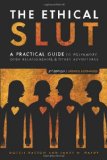I am leading a read-through of The Ethical Slut, 2nd edition. If you’d like to catch up on past installments, check the list at the bottom of the series introduction. Comments on the topics in this discussion are welcome anytime, even from people who aren’t following along in the book.
In this installment we discuss Chapter 10, “Flirting And Cruising.”

This chapter is about the art of finding lovers, fuckbuddies, play partners and other sexual relationships out in the world. It has some of the same material as the chapter “Finding Partners” from the first edition. However, some material is different. There is a bigger emphasis on flirting itself, and a lengthy anecdote from the authors’ personal lives has been removed (just as has happened elsewhere in the book).
The authors suggest that the boundaries between “flirting” and “cruising” vary from person to person. For me, they are pretty clear: I just plain love to flirt. While I absolutely love to flirt with people who I want to (or am) having sex with, it’s also something of a reflex with me. I believe flirting confers no obligation, but is a fun way of recognizing the hot, sexual being one is interacting with in a mutually agreeable fashion. Even if it never goes further, I enjoy the banter and the interaction of two alert intellects that can take place. I liked that Easton & Hardy encourage their readers to experience the joys of flirting for its own sake, too. As they point out accurately, the best flirting isn’t about skeevy pick up lines, but about recognizing the unique attractiveness of the person in front of you:
“Great flirting is about seeing; hunger to be seen is a natural human emotion, and when you show people that you’re seeing them, it’s natural for them to start seeing you.” –The Ethical Slut
Although I believe there is a section later about online dating or personal ads, this is as true in that arena as it is in the offline world. The most successful approaches are brief, friendly, and focus on some non-physical aspect of the recipient’s personality — the exact opposite of messages like ‘Hey nice breasts’ or the long messages mostly sent by men who copy-paste the same ego-boosting diatribe to dozens of women.
“The best, most successful, and least obnoxious cruisers we know, of all orientations, are friendly, curious folks who like most people and are interested in talking to everyone.” –The Ethical Slut
A lot of good flirting is just about conversation. But at some point it does switch over to something with intent — perhaps the dividing line where flirting becomes cruising, though the latter is not a word I have ever really used. One thing I have noticed is that when one begins flirting with intent, the conversation drifts toward the sexual interests of each participant. It’s almost like exchanging sexual resumes — each is sounding out the others involved for where mutual fetishes and turn-ons lie, what the other is experienced with or perhaps has always wanted to try. There’s a sense of possibility that enters these discussions which is exciting.

As both the book and this read-along have touched on before, this chapter again comes around to boundaries and the ways men and women have to unlearn bad cultural habits in regards to saying yes or no, or to hearing the same from those they are interested in. When you are going out looking for potential new lovers, it’s important to do so with knowledge of your interests and limits and with confidence in your ability to enforce them. Some people reading this who are on the dominant end of the spectrum may have encountered a very inexperienced submissive or bottom who claims to have no limits, or perhaps instructs the dominant to ‘do anything to me.’
While this makes for a hot fantasy, the reality is that kinky encounters function better when there is an understanding of the limits and mutual interests. A good dominant wants to “have their way” with their play partner while simultaneously appealing to their play partners desires, though sometimes these are desires they won’t always admit in the light of day. Of course, the reality is that everyone has limits and often surprising or counterintuitive ones. What might be one person giggle with pleasure is a safe-word inducing hard limit for another. This recent article by Clarisse Thorn is a moving and eloquent examination of the importance of learning to set boundaries.
There’s not a lot of advice in this chapter for what to do if you are terrible at reading people, but one thing that always works and that this book does emphasize is polite directness (while being willing to take no for an answer). Some of the best sexual encounters I have had have been as a result of a direct approach by my lover. Though I also love to initiate, there’s nothing quite like being told in explicit terms what is wanted and finding that you very much want that too. Direct, blunt women especially are a huge turn on for me — a clear memory I have is of making out with a former partner for the first time and wondering how much further we would be going only to have her look at me submissively and ask, “Would you like me to be naked now?”
One thing that actually frustrated me at one time about the kink community was what I at first perceived as a frustrating indirectness from many submissives. And while there certainly are times and people for whom this is true, I have also come to realize that I needed to acclimate to a different way of asking. For many of those on the sub end of the spectrum, I have found these more subtle requests often begin by way of sharing fantasies, or with looks and gestures and movements and other signals that say ‘I am going to pretend otherwise but dear god please do this to me.’ However the ability to read this form of directness requires both a knowledge of the kink scene and it’s cultural signals as well as, more importantly, intimate knowledge of the individual and of course their consent. None of this takes the place of negotiation, but it also isn’t the avoidance of it I once worried it might be.
Overall I enjoyed this chapter. The advice to couples about not objectifying one’s potential shared lovers was especially good. I do wish there was more advice for the socially clueless — what about the people unable to read signals? As someone who learned my social skills intuitively, it’s hard for me to guide others. I wish there was some way to point such people toward a sort of Social Cluefulness 101.
As an exercise for Chapter 10, Easton and Hardy suggest practicing saying Yes and No. If you’d like to join in on the comments, I’d love to hear about a time you made or received a direct request and were pleasantly surprised by the results of agreeing, or about a time you successfully set boundaries and enforced them to everyone’s benefit.
This read-along will continue on Thursday, March 17, 2011 with Chapter 11,”Keeping Sex Safe.”